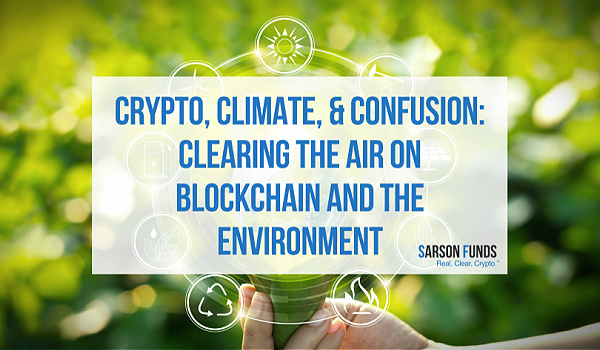Nathan Frankovitz
Millennials lead other generations on investing in two hot topics: Crypto assets, plus climate and energy issues. Yet, some still argue that these investments are diametrically opposed due to the Bitcoin network’s considerable electrical demand. As of March 18th, 2021, the annual power consumption of the Bitcoin network was estimated to be 129 terawatt-hours (TWh), a staggering figure when compared to the entire country of Norway, which consumes 124 tWH annually.
Counterintuitively, however, this doesn’t mean Bitcoin has a negative net impact on the environment. Like warm and cold air forming a tornado in the Great Plains, a whirlwind of colliding hype and doubt is obscuring the facts underlying today’s crypto assets. Bill Maher went so far as to say, “Almost all the people who tout Bitcoin, the millennials, the Gen Zers, the Silicon Valley types, are money-hungry opportunists and you’re not allowed to pretend you care about the environment.” Strong words for someone who, just minutes earlier, admitted “I’ve read articles about cryptocurrency, I’ve had it explained to me, and I still don’t get it, and neither do you or anyone else.” Even Elon Musk seems conflicted, having taken actions for and against Bitcoin’s case for sustainability in the last month.
Accordingly, we must keep an open yet critical mind as we explore the interplay of finance and energy globally. Tweets and talk shows are insufficient for developing informed opinions on such a complex topic. We suggest Bill reads up on our industry-leading research before completely dismissing the fastest growing trillion dollar industry on earth.
Harvard Business Review’s May 2020 article “How Much Energy Does Bitcoin Actually Consume?” makes an important distinction: “…you cannot extrapolate the associated carbon emissions without knowing the precise energy mix — that is, the makeup of different energy sources used by the computers mining Bitcoin.” In other words, not all energy consumption incurs equal costs to the environment. Bitcoin mining is a game of margins, with the price of electricity being the chief factor. These incentives are driving miners towards “…better access to sustainable and renewable energy”, according to Argo Blockchain. In fact, data illustrating cost-efficacy improvements in wind and solar explain the 11% reduction in U.S. energy-related emissions of CO2 in 2020. As demand for decentralized finance grows, crypto mining is actually accelerating renewable resource adoption. Props to General Electric for predicting this trend in 2016.
The economic mechanism by which Bitcoin demand accelerates clean energy integration can be referred to as “energy arbitrage”. Essentially, certain places at certain times are exceptionally efficient at producing clean energy—the trouble is that these regions’ demand for electricity don’t always match production. In west Texas, Layer1’s Bitcoin mining operation perfectly illustrates the power of arbitrage. Most of the time, Layer1’s miners are busy converting cheap west Texan energy into Bitcoin. However, pursuant to their “demand response” contracts, Layer1 will shut down their machines to allow their 100 mw load to flow into the electrical grid. CEO and co-founder Alex Liegl explains, “We act as an insurance underwriter for the energy grid.” Ed Hirs, a University of Houston lecturer in energy economics adds, “It’s a lot cheaper option than building a whole new power plant or battery system just to keep it on standby.”
This form of arbitrage is replicated globally. In Iceland, “…abundant water and underground heat is harnessed by hydroelectric dams and geothermal power stations to produce cheap, green electricity that facilitates the energy-intensive process of confirming cryptocurrency transactions”, according to wired.com. In Sichuan China, Bitcoin enables overbuilt hydroelectric operations to make use of excess energy, as explained by Coindesk’s Nic Carter. “If your local energy cost is effectively zero but you cannot sell your energy anywhere, the existence of a global buyer for energy is a godsend.” The existence of Bitcoin’s global market de-risks renewable energy development as investors seek optimal conditions on the edges of civilization.
We must also consider the impetus for Bitcoin’s rapidly growing global market: demand for a decentralized financial system. Progress towards this vision has been considerable since the onset of the COVID-19 pandemic, which spurred unprecedented manipulation of the monetary supply by centralized banks. This begs the question: how energy intensive are the financial systems that currently exist which Bitcoin and its orbiting crypto assets show promise to replace?
Let’s begin with the predominant narrative on Bitcoin today: Bitcoin replaces gold as a store of value. A 2019 study by Arca demonstrates how “gold mining in terms of crude oil usage accounts for 0.27% of worldwide oil consumption (directly comparable to Bitcoin’s electricity share)”. This approximation of equal environmental costs comes before factoring in gold transportation, storage, etc., in addition to the energy mix concept previously addressed. It also doesn’t account for decentralized finance’s ability to replace enormous shares of the traditional financial systems which expend energy across countless verticals. Bank branches, capital expenditures, employee commutes, aluminum mining, currency smelting, distribution, custody, etc. are just a few of the ways the legacy financial system expends energy to uphold a far less egalitarian and convenient monetary system. By virtue of being more perfectly scarce, more durable, and easier to transport, Bitcoin’s “distributed ledger technology” reduces the friction associated with gold’s (and other financial instruments’) existing use cases while opening new possibilities through its composability in smart contracts. The resulting reduction in friction allows financial systems to scale, accelerating financial inclusion for the “unbanked” and “underbanked”, as described in Deloitte’s Inside magazine issue 19.
Equalizing access to financial services is not only a moral imperative, but an economic interest for all global-minded citizens. Many governments around the world practice ineffective and even abusive monetary policies that stifle innovation, such as in Venezuela. As the Venezuelan bolivar collapses, people are investing in food and water and resorting to bartering to preserve their purchasing power. These ancient ways of storing and exchanging value are clearly inefficient, and regression towards their use robs people of their life savings, time, and humanity. As we progress towards an increasingly globalized world, the billions left behind under such tumultuous economic conditions have little chance of realizing their potential. As a result, we all suffer.
In 1999, Forbes published an article titled, “Dig more coal — the PCs are coming”. In retrospect, these old skepticisms seem absurd. Inevitably, disruptive technologies create fear, uncertainty, and doubt—especially among those who hold stake in the aging systems. Like JP Morgan in 2017, incumbents cry foul until they realize what’s happening. “If you can’t beat them, join them” would make a great title for a memoir of these times in which financial institutions are piling into the crypto universe.
At Sarson Funds, we are not dogmatic about crypto investments. Our role is to provide evidence-based educational content on the rapidly developing realm of crypto assets while managing a broad set of portfolios for investors. We deeply respect the complexity of these emerging markets. Accordingly, we carefully choose which crypto projects we back. Though many projects will rise and fall in the coming years, a fundamental truth remains: We are dedicated to championing a future where all global citizens are united by access to fair monetary systems, financial services, and digital sovereignty.







